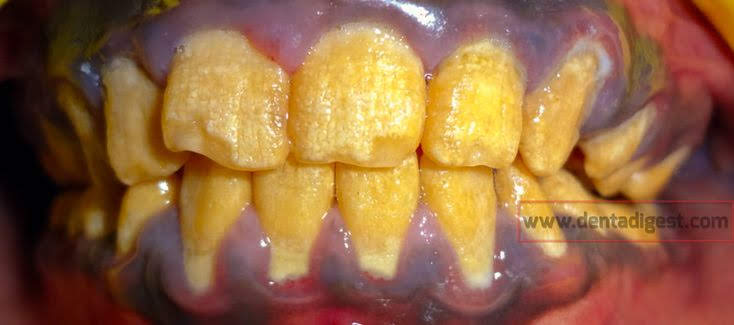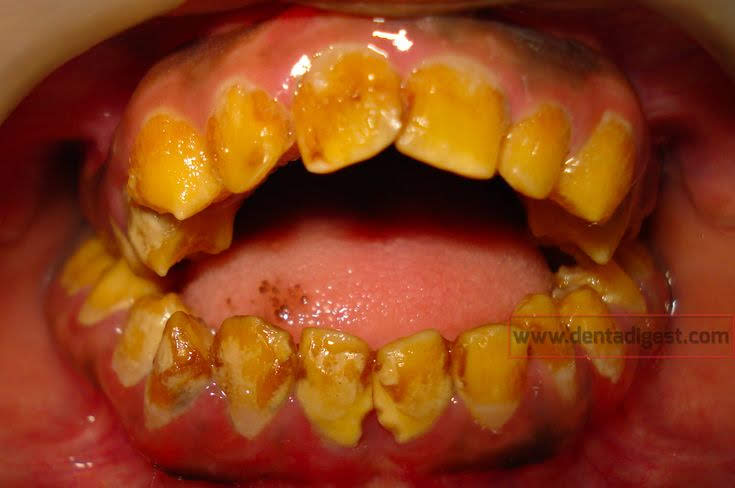There are many reasons for yellow teeth. One such condition that we are discussing today is AMELOGENESIS imperfect.
Before going into its detail let me explain the structure of teeth. Teeth contain 2 protective layers above the central vital portion (which is called pulp which contains nerves accompanied by blood vessels).
The 2 layers are called Enamel and Dentin. Enamel is the outermost layer of teeth and is usually white with more translucency. In addition to it, the second layer is dentin which is present beyond the enamel and is yellow.
The yellowish hue of teeth is dependent on the thickness of enamel. The thicker the enamel, the more is its white color, as the translucency of enamel decreases and vice versa. Hence one reason for yellow teeth can be because of THIN ENAMEL.
Reference
AMELOGENESIS IMPERFECTA (AI) is a rare genetic disorder that runs in families. It is characterized by the improper formation of enamel over dentin. As a result, the teeth appear yellow in color.
Also read: THE DARK SIDE OF TEETH WHITENING – EXPOSED
Take the first step to a better Oral health!
Get tips on Oral health and discover ways to improve your Dental health. Sign up today
REASON FOR YELLOW TEETH FROM AMELOGENESIS IMPERFECTA
In most cases, AI is related to genetic mismatch which usually occurs in the case of consanguinity. Yes! If parents are relatives and have the same genetic setup, then the chance of AI in their siblings is more. These cases are usually seen in South Asian countries like India, where consanguineous marriages are more.
In addition to it, the other reasons might include a mutation in genes coding for certain proteins like enamelin ameloblastin, and amelogenin can result in altered or improper formation of enamel.
TYPES OF AMELOGENESIS IMPERFECTA
To understand various types of AI, let us know how enamel forms on teeth. The description given below is for the basic understanding of the concept of AI for a common man.
Usually, enamel formation occurs in 3 phases. The first phase is the FORMATIVE PHASE, where the enamel matrix or organic matrix will form at the time of the formation of teeth.
A thin matrix results in thin enamel formation. Such a condition is seen in HYPOPLASTIC VARIANT OF AMELOGENESIS IMPERFECT.


The second stage is the CALCIFICATION PHASE, where mineralization of this enamel matrix with calcium and phosphorus occurs.
Moreover, any effect on teeth at this stage can result in HYPOCALCIFIED AMELOGENESIS imperfecta.
As the calcification or mineralization does not occur properly, there is more chance that this enamel can be easily chipped off leaving the rough and rugged dentinal surface exposed.
Also read: CHIPPED TOOTH-BEST TREATMENT OPTIONS

The third stage is the MATURATION PHASE, where the calcified crystals enlarge and fuse to form an even enamel surface with specific thickness and strength.
Sadly, an improper maturation phase can result in areas of hypomaturation resulting in irregular calcified areas on the tooth surface. This is the HYPOMATURATION VARIANT OF AMELOGENESIS IMPERFECTA.

WHAT IS THE TREATMENT FOR AMELOGENESIS IMPERFECTA
Usually, patients with a severe expression of AI will lose their tooth structure within a few years of eruption. The treatment plan for AI depends on its type. Hence after diagnosis of AI, it is better to consult your dentist for a detailed treatment plan.
Also read: TARTAR ON TEETH. HOW DO I MANAGE DENTAL CALCULUS?
During the dental visit, your dentist might check your teeth for any abnormality. He may assess the longevity of your teeth. Teeth with a poor prognosis might be removed.
Teeth with good to moderate response may require a root canal with a crown. This helps in protecting the remaining tooth structure and the tooth survival rate can be increased.
Also, read Signs of infection after a root canal.
HOW CAN I JUDGE THE PROGNOSIS OF TEETH IN AI
Teeth with Questionable prognosis are usually more brittle and have already lost some portion. Such teeth cannot survive for longer duration.
The structure of such teeth will wash out slowly resulting in complete loss of teeth. Early intervention of such teeth is vital in increasing longevity of teeth.
This can increase the survival rate of such teeth. Hence I recommend every patient with AI have a thorough checkup at the earliest possible.
In addition, If you like the post, please do share it with your friends. Sharing is caring. In case of doubt or questions feel free to comment below. It will be my pleasure to answer your questions
FAQ
What is Amelogenesis Imperfecta (AI)?
AI is a rare genetic disorder causing improper enamel formation over the dentin, resulting in yellowish teeth due to thin or irregular enamel.
What causes yellow teeth due to Amelogenesis Imperfecta?
AI can result from genetic mismatches, especially in cases of closely related parents, or mutations in genes responsible for enamel-related proteins like enamelin, ameloblastin, and amelogenin.
How does Amelogenesis Imperfecta affect enamel formation?
AI has different variants: hypoplastic, hypocalcified, and hypomaturation. Each variant disrupts specific stages of enamel formation, leading to thin, easily chipped, or irregularly formed enamel.
Is Amelogenesis Imperfecta treatable?
Treatment depends on the severity and type of AI. Severe cases might require tooth extraction, while better-preserved teeth might benefit from root canals and crowns to protect the remaining tooth structure.
Can yellow teeth due to Amelogenesis Imperfecta be prevented?
AI is a genetic disorder, so prevention might not be possible. However, early diagnosis and intervention can help preserve affected teeth and increase their longevity.
How can I assess the prognosis of teeth affected by Amelogenesis Imperfecta?
Teeth with AI may show signs of brittleness, structural damage, or early loss of enamel. Consulting a dentist for a thorough examination can help determine the prognosis and necessary intervention.
Are there any specific regions or populations more affected by Amelogenesis Imperfecta?
AI cases are more prevalent in regions where consanguineous marriages occur frequently, such as certain areas in South Asia, due to increased chances of genetic mismatches.
Can cosmetic treatments like teeth whitening help with yellow teeth caused by Amelogenesis Imperfecta?
Cosmetic treatments might not be effective for AI-related yellow teeth because the issue lies in improper enamel formation due to genetic factors rather than surface staining.
How can one differentiate between yellow teeth caused by Amelogenesis Imperfecta and other reasons for teeth discoloration?
AI-related yellow teeth have a distinct pattern of thin or irregular enamel formation, usually present since the eruption of teeth, unlike discoloration caused by external factors.
What should individuals with Amelogenesis Imperfecta do for proper dental care?
Regular dental check-ups and early intervention are crucial. Consulting a dentist for personalized advice on preserving teeth affected by AI is essential for maintaining oral health.
- Is oral hygiene compulsory for kids? - January 13, 2023
- How to Choose the Best Dental Crown for Your Smile? - December 8, 2022
- Who needs antibiotics before dental work? What is antibiotic prophylaxis? - October 31, 2022



Pingback: CHIPPED TOOTH-BEST TREATMENT OPTIONS - DENTA DIGEST
Pingback: THE DARK SIDE OF TEETH WHITENING - EXPOSED - DENTA DIGEST
Pingback: CAN 4 IMPLANTS REPLACE ALL MY TEETH? ALL ON 4 CONCEPT | DENTA DIGEST